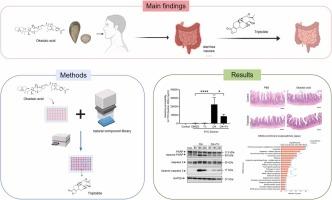天然化合物文库筛选确定雷公藤甲素治疗冈田酸诱导的肠道功能障碍。
IF 6.1
2区 环境科学与生态学
Q1 ENVIRONMENTAL SCIENCES
引用次数: 0
摘要
冈田酸(OA)是一种腹泻性贝类毒素,可引起显著的肠道和全身毒性。目前,还没有批准的治疗药物专门针对oa引起的腹泻。通过对2131种天然化合物的高通量筛选,我们发现雷公藤甲素是一种具有抗oa诱导的细胞凋亡保护作用的化合物。在暴露于OA的小鼠中,雷公藤甲素降低了肠通透性并改善了粘膜损伤。在HUVECs中,雷公藤甲素(0.1- μM)剂量依赖性地增加细胞活力并抑制凋亡活性。基于生物素的标记确定了羟基是雷公藤甲素的基本活性位点。RNA测序分析表明,雷公藤甲素抑制oa诱导的内质网(ER)蛋白合成相关基因的上调。此外,雷公藤甲素还能抑制oa诱导的p-eIF-2α/eIF-2α比值的降低,从而减弱内质网应激。这些结果表明雷公藤甲素通过抑制内质网应激介导的内皮细胞凋亡和维持肠道屏障完整性来减轻oa诱导的毒性,突出了其作为oa相关中毒治疗药物的潜力。本文章由计算机程序翻译,如有差异,请以英文原文为准。

Natural compound library screening identifies triptolide for the treatment of okadaic acid-induced intestinal dysfunction
Okadaic acid (OA), a diarrhetic shellfish toxin, causes significant intestinal and systemic toxicity. Currently, there are no approved therapeutics specifically targeting OA-induced diarrhea. Using high-throughput screening of 2131 natural compounds, we identified triptolide as a compound conferring protection against OA-induced apoptosis. In mice exposed to OA, triptolide administration reduced intestinal permeability and ameliorated mucosal injury. In HUVECs, triptolide (0.1–3 μM) dose-dependently increased cell viability and suppressed apoptotic activity. Biotin-based labeling identified the hydroxyl group as the essential active site of triptolide. RNA sequencing analysis showed that triptolide inhibited the OA-induced upregulation of endoplasmic reticulum (ER) protein synthesis-related genes. Furthermore, triptolide prevented the OA-induced decrease in the p-eIF-2α/eIF-2α ratio, thereby attenuating ER stress. These results demonstrate that triptolide mitigates OA-induced toxicity by inhibiting ER stress-mediated endothelial cell apoptosis and maintaining intestinal barrier integrity, highlighting its potential as a therapeutic agent against OA-related poisoning.
求助全文
通过发布文献求助,成功后即可免费获取论文全文。
去求助
来源期刊
CiteScore
12.10
自引率
5.90%
发文量
1234
审稿时长
88 days
期刊介绍:
Ecotoxicology and Environmental Safety is a multi-disciplinary journal that focuses on understanding the exposure and effects of environmental contamination on organisms including human health. The scope of the journal covers three main themes. The topics within these themes, indicated below, include (but are not limited to) the following: Ecotoxicology、Environmental Chemistry、Environmental Safety etc.

 求助内容:
求助内容: 应助结果提醒方式:
应助结果提醒方式:


